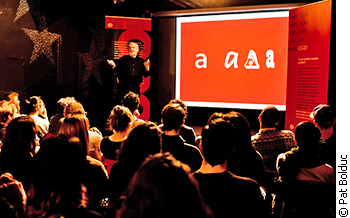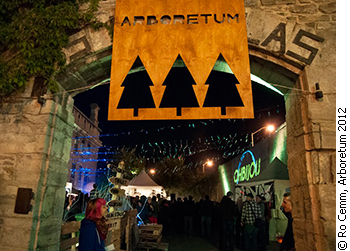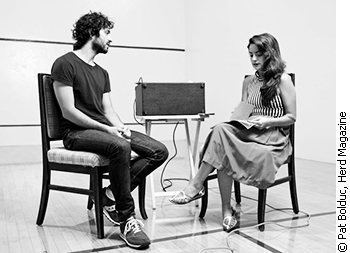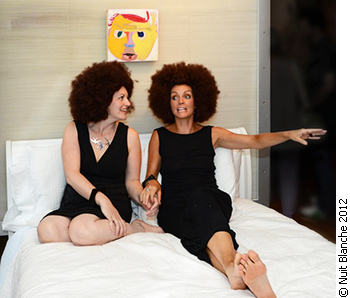Tags
Related Posts
Share This
Twenty- and thirty-somethings set to turn Ottawa into arts capital
Ottawa may be set to shed its image as a sleepy government town with a recent boom in local arts and culture led by 20- and 30-somethings. “We are undergoing a 613 renaissance,” says arts blogger Ryan Saxby Hill.
The city has seen a burgeoning of cultural initiatives, particularly in the last year. According to Saxby Hill – whose blog Apartment613 has followed arts in Ottawa since 2008 – a momentum of recent years culminated in 2012 with Ottawa ‘firsts’ such as the Arboretum arts and music festival and an inaugural Nuit Blanche (an all-night arts festival held internationally), as well as magazine launches, new late-night restaurants, and international arts lectures like Creative Mornings.
Organizers say they anticipate these initiatives will continue this year, marking a shift in local arts and culture. Hip, innovative, and interesting music, art, food, and venues are on Ottawa’s new ‘cool’ menu, and the movement is growing. All of last year’s local arts and culture initiatives were successes – surprisingly so, some organizers admit.

Typographer Rod McDonald talked about fonts to a full house for Creative Mornings at SAW Gallery in November.
“More than 30,000 people came out to the city’s first Nuit Blanche. I was blown away by the support and creativity in Ottawa,” says Megan Smith, a 30-something who co-curated the all-night arts festival, held on Sept. 22, 2012. “I am inspired as a curator and as an artist,” she says, explaining that organizers had expected only 10,000 people for the inaugural event.
The city’s Creative Mornings chapter, which is part of an international initiative started in New York City with chapters around the world organizing free arts lectures, has also been a hit, according to co-founder Michael Grigoriev, an industrial design student at Carleton University.
“Attendance [at Creative Mornings] has far surpassed our wildest dreams,” says Grigoriev, explaining that each of the monthly lectures, which started last March, has reached the capacity of 100 people at venues like SAW Gallery near the Rideau Centre. “We distribute tickets online, and they are snapped up immediately,” he says, noting the wide audience Creative Mornings attracts – from his peers to government employees and older professionals – by ensuring a variety of speakers, such as local tattoo artists, designers, chefs, and entrepreneurs.
“We have a lot to offer. We have a lot of talent in this city and opportunities to make with all that,” says Grigoriev. None of these initiatives are mandated by the City; they are all volunteer-run by “20-somethings who are realizing they should try to do something special in [Ottawa].”
“For too long Ottawa has been known as a boring government town,” he asserts. “People are tired of the status quo … tired of following Toronto and Montreal’s creative scenes and comparing themselves.”
Grigoriev, 26, is one of the millennials driving arts and culture initiatives in Ottawa. He emphasizes that recent successes like Creative Mornings and Nuit Blanche are part of a wider momentum and optimism that has been building in creative communities in the past six to 12 months, as attitudes among 20- and 30-somethings have switched from ‘Ottawa sucks’ to ‘let’s do something about it, let’s be proactive.’

The Jail Hostel rocked with Ottawa’s first Arboretum Festival.
“There seems to be a critical mass of efforts and excitement lately,” agrees Rolf Klausener, a 30-something musician from Ottawa band The Acorn. “From one week to the next, people are putting on events … and just perpetuating the feeling that we are an active, thriving city.” He is his own example, having co-organized the city’s inaugural Arboretum Festival, showcasing local music, arts, and foods, on Sept. 15, 2012, at the Ottawa Jail Hostel and Arts Court downtown.
“Creative young people are not just leaving Ottawa anymore to go to Toronto or Montreal,” says Steve Harris, a chef in his early 30s who opened Two Six {Ate} on Preston Street in October. Instead, people are staying here to make their mark; they are not taking their talents elsewhere. Harris says he opened the restaurant with his girlfriend to fill a void: restaurants that offer quality local foods with full-menu service late at night. Two Six {Ate} stays open from 4 p.m. to 2 a.m. even on weekdays. Union Local 613 on Somerset Street West is another new restaurant opened by millennials, last July, to offer local foods later at night.
Stephanie Vicente, 27, a co-founder of the monthly publication Herd Magazine, which started in October to highlight Ottawa’s arts and culture, says these initiatives reflect that her generation is growing up. “All our parents are baby boomers who are getting ready to retire or already have so it is starting to open the door for us. It is now our turn to take on leadership roles in whatever industry we are interested in,” she says.

Herd Magazine co-founder Stephanie Vicente interviewed local musician Adam Saikaley for the first issue, released in October.
“Everyone wants to be part of something fresh and interesting,” says Vicente, noting collaboration as another important factor in successful local initiatives. The collaboration a smaller city like Ottawa allows is nurturing the local arts renaissance, as creative communities become increasingly connected.
For example, she explains, Herd Magazine collaborated with Fall Down Gallery on Bank Street to host its launch party; this attracted more than 500 people to the gallery, providing a boost to fellow millennials who had opened that small business in 2011.
Similarly, Nuit Blanche brought business to downtown small shops, many run by 20- and 30-somethings, by partnering with them to host 120 art exhibits across the city. The local venues included Victoire on Dalhousie Street and La Petite Mort gallery on Cumberland. Such collaborations raised public awareness of these businesses, says Vicente who attended the festival.

Nuit Blanche curators Megan Smith (left) and Lainie Towell topped up the night’s performance arts by inviting strangers to bed with them at various galleries.
New events also serve to complement older events like Ottawa Explosion (a punk music festival started in June 2011) and House of PainT (a graffiti and slam poetry festival held each September since 2003), to help build the city’s self-esteem and feed its creativity, says Nuit Blanche’s Smith.
The beauty behind the creative boom is that it is emerging from millennials’ genuine desires to do something with this city to build civic pride and community, says Grigoriev of Creative Mornings.
“We do our own things well,” he says, pointing to the innovative restaurants and festivals that Ottawa welcomed last year as testaments to local talent. “I think the city is slowly developing more discerning tastes and standards … We do not need to feel like second-class creative citizens anymore.”
Such sentiments are expected to continue this year as lessons in civic pride carry over. Creative Mornings and Nuit Blanche are gaining traction, organizers say. Herd Magazine is launching its second issue, in January 2013, and Arboretum Festival founders say they are planning more local music and food-based events for 2013.
Despite the successes of 2012, organizers admit they may need some municipal funding to grow beyond independent, small-scale festivals, lectures with restricted capacity, and free magazine.
But for now, it is simply about celebrating local talent as the city nurtures a more artistic identity, says Vicente. “I think Ottawa is finally accepting [it] is Ottawa … It is not about trying to be Toronto or Montreal.”
Check out Ottawa’s expanding culture scene
- PechaKucha is a free event held at local galleries, universities, bars, and restaurants, for creative types such as artists and architects, to showcase their work publicly, usually through a slideshow. Ottawa has hosted PechaKucha nights every few months since 2010 as one of some 500 cities around the world that participate in the event, which started in Tokyo.
- The Hub is a collective workspace that opened in Ottawa last year as part of an international initiative that is spread from London, U.K., to Johannesburg, South Africa. Ottawans can drop in or purchase a monthly membership to enjoy the communal space, designed as an open-concept think-tank for people to interact and share ideas. The local Hub also hosts events such as Ottawa Creative Mornings.
- 71 Bank Street, 6th floor
- Since opening in 2011, Pressed Café has become synonymous with good local food and an interesting atmosphere, day and night. The hip venue hosts events regularly, including experimental music nights, youth poetry readings, and international language talks with speakers of all tongues.
- 750 Gladstone Avenue
- The Canadian Museum of Nature is transforming itself into a nightclub for the last Friday of the month, starting in early 2013. The event called Nature Nocturne invites Ottawans to enjoy live music, food, drinks, and a lounge surrounded by the museum's exhibits, including a tank of tarantulas!
- 240 McLeod Street
- Capital Chill is an art and live music lounge set up at Ottawa’s Arts Court. The inaugural night was held last May, but others are anticipated for 2013.
- 2 Daly Avenue





